The amount of water consumed everyday by Americans is astonishing – over 410 billion gallons. I can’t even put that into a comprehendible amount, just know that 410 billion gallons is a shit ton of water.

Photo courtesy of Google
Even Google can’t figure this one out for us.
As Americans, it is very hard for us to fathom a life without access to clean water. Imagine turning on your faucet and dirty water runs out, or maybe no water at all. Access to clean water – and a lot of it – is an expectation in the United States, and we often don’t think twice about how much water we are consuming.
So, why does this large water consumption of clean matter? Well, consuming such a large amount of water takes its toll on the environment, our wallets and, ultimately, our future.
Global water consumption is ridiculous, but what is more shocking is the unequal consumption of water globally – and where each country gets their water.
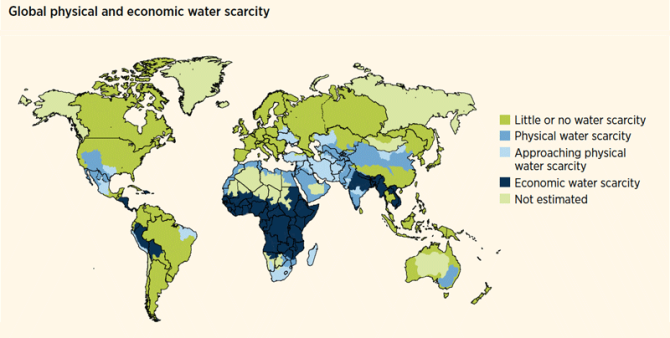
Photo courtesy of un.org
In the Netherlands, for example, 95% of their water footprint consumption comes from abroad. But in Paraguay and India, for example, only 3% of their national water footprint comes from foreign countries. But external water consumption isn’t necessarily a bad thing. What is concerning, however, is each country’s average water footprint.
Americans have the biggest individual water footprint on the planet, but that should come as no surprise for y’all. The typical American consumes about 1,157 gallons of water per person per day.
Yemen has one of the smallest individual water footprints, as the average Yemeni consumes only about 108 gallons per person per day. What the hell, America?

Gif courtesy of giphy.com
So how do we use over 410 billion gallons of water every. Single. Day? And why does it matter?
Well, 80% of this 410 billion gallons of water is used in the production, transportation and consumption of food, which obviously takes a toll on the environment.

Gif courtesy of giphy.com
But, there is good news. Our generation has the power to redefine the future of food, and therefore the future of our environment.

Gif courtesy of giphy.com
So besides agriculture, how the average American consumes over a thousand gallons of water per day. Because really, I supposedly only drink eight 6-oz. glasses of water a day, right?

Gif courtesy of giphy.com
Well, there is showering, washing dishes, flushing toilets, washing hands and brushing teeth. But that equals less than 1/3 of the water we consume everyday. The rest of the water? Food.
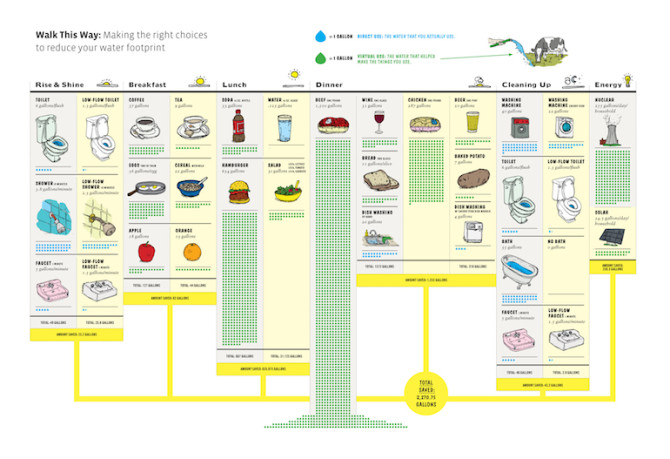
Photo courtesy of temp.waterfootprint.org
But how? It all comes down to “virtual water,” or hidden water usage. Most of the “virtual water” comes from the production of food. Crops obviously cannot grow without water, which is why agriculture in the United States is responsible for 80% of all the water consumed in this country. Whhhhaaat?
Not convinced? Let’s take a look at the amount of water that goes into producing one burger.
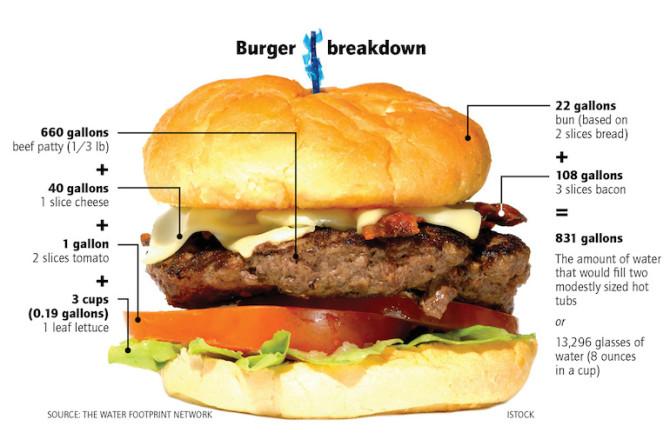
Photo courtesy of foodandwine.hu
A 1/3 pound beef patty requires 660 gallons of water, three slices of bacon require 108 gallons and one slice of cheese requires 40 gallons. One bun requires 22 gallons, two slices of tomato require one gallon of water and even one leaf of lettuce takes three cups of water.
And don’t forget fries. That’ll be another six gallons. Are you thirsty? Rinse your burger down with a soda, and that’s an additional 46 gallons of water.
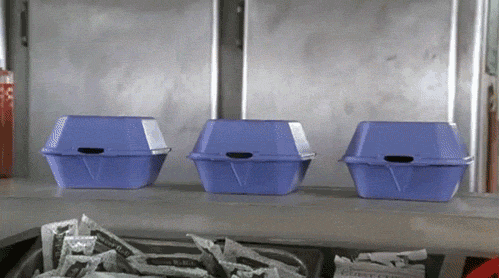
Gif courtesy of giphy.com
That’s 883 gallons of water consumed in one meal. Remember, the average Yemeni consumes only about 108 gallons per person per day.
The beef patty uses 660 gallons of water, whereas the rest of the ingredients only total 223 gallons – still a shit ton of water, but not even close to the amount of water required to produce the beef. Though a burger is probably not your typical lunch, it’s still important to understand the water footprint of meat, particularly beef.
It is clear that meat and dairy products require a significantly greater amount of water than grains and vegetables. But why?
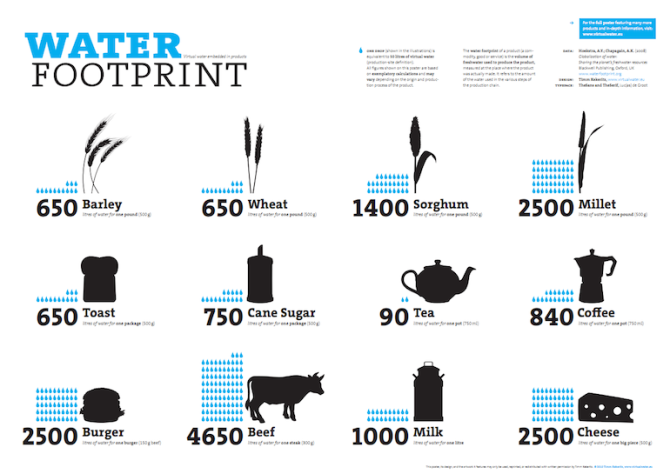
Water Footprint in Liters, Photo courtesy of printage.wordpress.com
A single pound of beef requires about 1,800 gallons of water. 1,800 gallons of water. But why, or how, does it take that much water to produce beef? First, let’s think about the foods cattle eat.
In the United States, over 80% of beef cattle are raised “conventionally,” which means that they eat in a grass pasture for about 13 months. Then, the cattle are transferred to feedlots, where they spend three to six months eating corn and soy.
And guess what. It takes 147 gallons of water to produce one pound of corn, and beef cattle can eat over 1,000 pounds of feed while on the feedlot. So that’s a shit ton of water usage from their food.
But it’s not only the cattle food and drink that contributes to the water footprint. Think about the amount of water that is needed to grow the grass for grazing. Plus the water required for cleaning, processing and transporting. So. Much. Water.

Gif courtesy of giphy.com
But let’s back up for a second. Because, of course, meat is not the only food that requires a lot of water. Surprisingly coffee requires a lottt of water – 2,496 gallons of water to produce one pound of coffee.

Gif courtesy of giphy.com
Vegetables, fruits , grains and beans require water to grow – duh. Animals that you eat, such as cattle, pigs and chickens, need food, which require water. So it makes sense that the agricultural industry sucks up so much of our water – either you directly eat vegetables, which require water, or your food eats vegetables, which requires water.

Photo courtesy of businessinsider.com
Now, I can’t talk about this country’s insane water usage without discussing California’s drought.
California produces more food than any other state, from milk to beef, nuts to produce. And, of course, this is an immense drain on its resources. And because California is in an awful, historic drought, its agricultural sector uses a large amount of the southwest’s water supply, not exclusively California’s supply.

Gif courtesy of giphy.com
So not only is California growing and producing the most food nationwide, but they are also transporting this food across the country. And transporting food requires a great deal of resources, including water, of course.
Guess what. The gasoline that it takes to drive one mile takes about 3/4 gallons of water. Whhhhatttttttt. Yes, 3/4 gallons of water for every. single. mile. How? Well, it takes approximately 1-2.5 gallons of water to refine one gallon of gasoline.

Gif courtesy of giphy.com
So that California orange that you’re eating had to drive all the way across the country to make it into your grocery store, and then into your kitchen. You are not just consuming an orange – you are consuming more than 14 gallons of water, depending on where you live in the United States.

Gif courtesy of giphy.com
This might be obvious, but using over 410 billion gallons of water everyday is bad. So, we need to rethink how we think about our water usage. In order to actually conserve water, we have to do more than just leaving it “mellow.” We have to conserve all aspects of our lives, including our shopping, transportation and eating habits. But let’s focus on food for now.
How can you reasonably reduce your water footprint in relation to food? The first step, of course, is awareness. It is important to understand where your food comes from and how it is made. But the most impactful and obvious way to reduce your water footprint is altering your diet. But in what way?
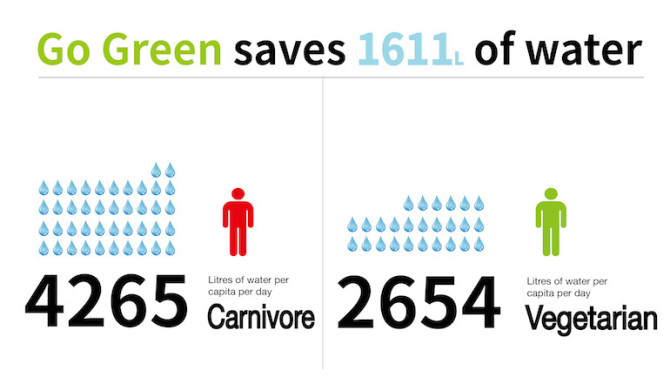
Photo courtesy of greenmonday.org
Stop eating meat. It’s simple, and hopefully pretty obvious. But if you’re not ready to make the switch to vegetarianism, try eating less meat each week. If you go meatless, for even just one day a week, you will significantly reduce your weekly water usage.
Eat produce. People that eat a lot of highly processed foods, such as candy, chips and microwaveable meals, are using more water than people who eat unprocessed foods, such as fresh fruits and vegetables.
A bag of potato chips, for example, requires way more water than a regular potato. Think about it. First, you have to grow the potato, then clean the potato (and the machinery), produce cooking oil for deep frying, produce packaging, plus more. It requires so much more effort (and man power), and as a result so much more water.
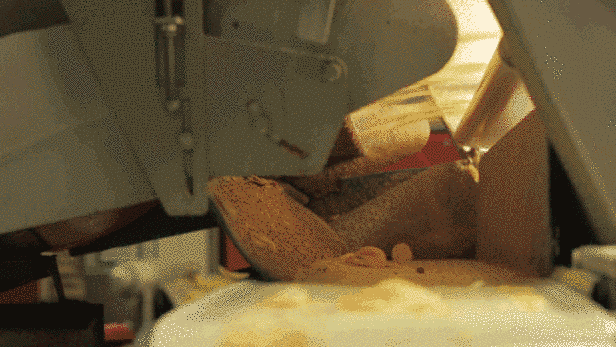
Gif courtesy of giphy.com
But don’t just eat any produce. Eat local fruits and vegetables, which will cut down on water required for transportation, plus carbon emissions. And you’ll be supporting your local community. A win-win-win.
Of course, if you live in dry, less arable places, such as Texas, Arizona or Georgia, it is harder to eat local. So just try to eat as local as possible and adapt your diet to your environment.
The more meat, dairy and processed food we consume, the more water we consume. Simple. So, start making environmentally responsible decisions.


